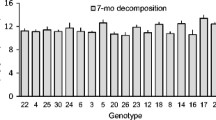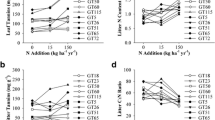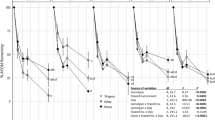Abstract
Recent research has shown that genetic variation can directly impact community and ecosystem level processes. Populus tremuloides (trembling aspen) is an extremely widespread and genetically diverse tree species important to many North American forest ecosystems. Using leaf litter from five genotypes grown in a common garden under two nutrient treatments, we tracked litter decomposition in a natural aspen stand for 1 year. Here we show that aspen leaf litter decomposes and releases carbon, nitrogen, and sulfur in relation to its genetic identity. In a secondary experiment, we show that the genetic diversity of aspen litter mixtures can influence decomposition, however weakly so. Overall, nutrient treatments influenced leaf litter decomposition the most, followed by genetic identity, and then by genetic diversity (if at all in some cases). In this widespread, genetically diverse, and dominant species, genetic variation within a single species is important to ecosystem functioning. The relatively weak effect of genetic diversity on the processes measured here does not preclude its importance to ecosystem functioning, but does suggest that genetic identity and composition are more important than genetic diversity per se.






Similar content being viewed by others
References
Aber JD, Melillo JM, McClaugherty CA. 1990. Predicting long-term patterns of mass loss, nitrogen dynamics, and soil organic matter formation from initial fine litter chemistry in temperate forest ecosystems. Can J Bot 68:2201–8
Bailey JK, Schweitzer JA, Rehill BJ, Lindroth RL, Martinsen GD, Whitham TG. 2004. Beavers as molecular geneticists: a genetic basis to the foraging of an ecosystem engineer. Ecology 85:603–8
Booth RE, Grime JP. 2003. Effects of genetic impoverishment on plant community diversity. J Ecol 91:721–30
Bradford MA, Tordoff GM, Eggers T, Jones TH, Newington JE. 2002. Microbiota, fauna, and mesh size interactions in litter decomposition. Oikos 99:317–23
Chapman K, Whittaker JB, Heal OW. 1988. Metabolic and faunal activity in litters of tree mixtures compared with pure stands. Agric Ecosys Environ 24:33–40
Chase JM, Knight TM. 2003. Community genetics: towards a synthesis. Ecology 84:580–2
Coleman DC, Crossley DA. 1996. Fundamentals of soil ecology. San Diego (CA): Academic Press
Dawkins R. 1982. The extended phenotype. New York (NY): Oxford University Press
Donaldson JR, Lindroth RL. 2004. Cottonwood leaf beetle (Coleoptera: Chrysomelidae) performance in relation to variable phytochemistry in juvenile aspen (Populus tremuloides Michx.). Environ Entomol 33:1505–11
Gartner TB, Cardon ZG. 2004. Decomposition dynamics in mixed-species leaf litter. Oikos 104:230–46
Hättenschwiler S, Vitousek PM. 2000. The role of polyphenols in terrestrial ecosystem nutrient cycling. Trends Ecol Evol 15:238–43
Hagerman AE, Butler CG. 1989. Choosing appropriate methods and standards for assaying tannin. J Chem Ecol 15:1795–810
Hernes PJ, Hedges JI. 2004. Tannin signatures of barks, needles, leaves, cones, and wood at the molecular level. Geochimica et Cosmochimica Acta 68:1293–307
Hoorens B, Aerts R, Stroetenga M. 2002. Litter quality and interactive effects in litter mixtures: more negative interactions under elevated CO2? J Ecol 90:1009–16
Hunter MD. 2001. Insect population dynamics meets ecosystem ecology: Effects of herbivory on soil nutrient dynamics. Agric Forest Entomol 3:77–84
King JS, Pregitzer KS, Zak DR, Kubiske ME, Ashby JA, Holmes WE. 2001. Chemistry and decomposition of litter from Populus tremuloides Michaux grown at elevated atmospheric CO2 and varying N availability. Global Change Biol 7:65–74
Kraus TEC, Zasoski RJ, Dahlgren RA, Horwath WR, Preston CM. 2004. Carbon and nitrogen dynamics in a forest soil amended with purified tannins from different plant species. Soil Biol Biochem 36:309–21
Ledig FT. 1992. Human impacts on genetic diversity in forest ecosystems. Oikos 63:87–108
Lindroth RL, Roth S, Nordheim EV. 2001. Genotypic variation in response of quaking aspen (Populus tremuloides) to atmospheric CO2 enrichment. Oecologia 126:371–9
Lindroth RL, Osier TL, Barnhill HRH, Wood SA. 2002. Effects of genotype and nutrient availability on phytochemistry of trembling aspen (Populus tremuloides Michx.) during leaf senescence. Biochem Syst Ecol 30:297–307
Loreau M. 1998. Separating sampling and other effects in biodiversity experiments. Oikos 82:600–2
Madritch MD, Hunter MD. 2002. Phenotypic diversity influences ecosystem functioning in an oak sandhills community. Ecology 83:2084–90
Madritch MD, Hunter MD. 2003. Intraspecific litter diversity and nitrogen deposition affect nutrient dynamics and soil respiration. Oecologia 136:124–8
Martinsen GD, Floate KD, Waltz AM, Wimp GM, Whitham TG. 2000. Positive interactions between leafrollers and other arthropods enhance biodiversity on hybrid cottonwoods. Oecologia 123:82–9
McIntyre PJ, Whitham TG. 2003. Plant genotype affects long-term herbivore population dynamics and extinction: Conservation implications. Ecology 84:311–22
Melillo JM, Aber JD, Muratone JF. 1982. Nitrogen and lignin control of hardwood leaf litter decomposition dynamics. Ecology 63:621–6
Mitton JB, Grant MC. 1996. Genetic variation and the natural history of quaking aspen. Bioscience 46:25–31
Moore JC, Berlow EL, Coleman DC, de Ruiter PC, Dong Q, Hastings A, Johnson NC, McCann KS, Melville K, Morin PJ, Nadelhoffer K, Rosemond AD, Post DM, Sabo JL, Scow KM, Vanni MJ, Wall DH. 2004. Detritus, trophic dynamics and biodiversity. Ecol Lett 7:584–600
Nilsson MC, Wardle DA, Dahlberg A. 1999. Effects of plant litter species composition and diversity on the boreal forest plant-soil system. Oikos 86:16–26
Pastor J, Bockheim JG. 1984. Distribution and cycling of nutrients in an aspen-mixed-hardwood-spodosol ecosystem in northern Wisconsin. Ecology 65: 339–53
Perala DA, Alm AA. 1990. Reproductive ecology of birch–a review. Forest Ecol Manag 32:1–38
Porter LJ, Hrstich LN, Chan BC. 1986. The conversion of procyanidins and prodelphinidins to cyaniding and delphinidin. Phytochemistry 25:223–30
Prescott CE, Kabzems R, Zabek LM. 1999. Effects of fertilization on decomposition rates of Populus tremuloides foliar litter in a boreal forest. Can J Forest Res 29:393–7
Prescott CE, Zabek LM, Staley CL, Kabzems R. 2000. Variability in litter quality and its relationship to litter decay in Canadian forests. Can J Bot 78:1269–87
Salamanca EF, Kaneko N, Katagiri S. 1998. Effects of leaf litter mixtures on the decomposition of Quercus serrata and Pinus densiflora using field and laboratory microcosm methods. Ecol Eng 10:53–73
Schädler M, Brandl R. 2005. Do invertebrate decomposers affect the disappearance rate of litter mixtures? Soil Biol Biochem 37:329–37
Schimel JP, Van Cleve K, Cates RG, Clausen TP, Reichardt PB. 1996. Effects of balsam poplar (Populus balsamifera) tannins and low molecular weight phenolics on microbial activity in taiga floodplain soil: implications for changes in N cycling during succession. Can J Bot 74:84–90
Schweitzer JA, Bailey JK, Rehill BJ, Martinsen GD, Hart SC, Lindroth RL, Keim P, Whitham TG. 2004. Genetically based trait in a dominant tree affects ecosystem processes. Ecol Lett 7:127–34
Sellmer JC, McCown BH, Haissig BE. 1989. Shoot culture dynamics of 6 Populus clones. Tree Physiol 5:219–27
Treseder KL, Vitousek PM. 2001. Potential ecosystem-level effects of genetic variation among populations of Metrosideros polymorpha from a soil fertility gradient in Hawaii. Oecologia 126:266–75
Vitousek PM, Mooney HA, Lubchenco L, Melillo JM. 1997. Human domination of Earth’s ecosystems. Science 277:494–9
Wardle DA, Bonner KI, Nicholson KS. 1997. Biodiversity and plant litter: experimental evidence which does not support the view that enhanced species richness improves ecosystem function. Oikos 79:247–58
Whitham TG, Young WP, Martinsen GD, Gehring CA, Schweitzer JA, Shuster SM, Wimp GM, Fischer DG, Bailey JK, Lindroth RL, Woolbright S, Kuske CR. 2003. Community and ecosystem genetics: a consequence of the extended phenotype. Ecology 84:559–73
Wimp GM, Young WP, Woolbright SA, Martinsen GD, Keim P, Whitham TG. 2004. Conserving plant genetic diversity for dependent animal communities. Ecol Lett 7:776–80
Acknowledgements
Funding was provided by NSF DEB-0074427 to RLL and by NSF DEB-0344019 to RLL and MDM. We thank M. Leach and the UW Arboretum staff for site use permission and location assistance. C. Cole generously provided microsatellite data. We also thank H. Barnhill, K. Lawson, L. Riel, and B. Rogers for field and laboratory assistance.
Author information
Authors and Affiliations
Corresponding author
Rights and permissions
About this article
Cite this article
Madritch, M., Donaldson, J.R. & Lindroth, R.L. Genetic Identity of Populus tremuloides Litter Influences Decomposition and Nutrient Release in a Mixed Forest Stand. Ecosystems 9, 528–537 (2006). https://doi.org/10.1007/s10021-006-0008-2
Received:
Accepted:
Published:
Issue Date:
DOI: https://doi.org/10.1007/s10021-006-0008-2




